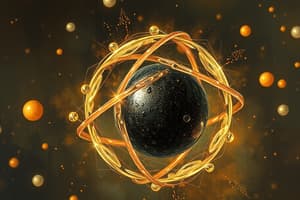Podcast
Questions and Answers
What characterizes the modern atomic model in contrast to early models?
What characterizes the modern atomic model in contrast to early models?
- It simplifies atoms as indivisible particles.
- It recognizes the fixed paths of electrons.
- It considers only the nucleus in atomic calculations.
- It explains the probabilistic behavior of electrons. (correct)
What defines the atomic radius of an atom?
What defines the atomic radius of an atom?
- The distance from the nucleus to its outermost electron.
- Half the distance between the nuclei of two bonded identical atoms. (correct)
- The volume occupied by an atom in a molecule.
- The average distance of electrons from the nucleus.
How does the atomic radius change across the periodic table?
How does the atomic radius change across the periodic table?
- It only varies in noble gases.
- It increases down a group and decreases across a period. (correct)
- It decreases down a group and increases across a period.
- It remains constant across periods.
What trend is observed in ionization energy across a period?
What trend is observed in ionization energy across a period?
What occurs when removing subsequent electrons from an atom?
What occurs when removing subsequent electrons from an atom?
What particles are located in an atom's nucleus?
What particles are located in an atom's nucleus?
Which statement accurately describes the atomic number of an element?
Which statement accurately describes the atomic number of an element?
What is the mass number of an atom?
What is the mass number of an atom?
Which of the following statements about isotopes is correct?
Which of the following statements about isotopes is correct?
What determines the electron configuration of an atom?
What determines the electron configuration of an atom?
According to the Aufbau principle, how do electrons fill the atom's energy levels?
According to the Aufbau principle, how do electrons fill the atom's energy levels?
Which historical atomic model was replaced by the current quantum mechanical model?
Which historical atomic model was replaced by the current quantum mechanical model?
Why are atoms considered electrically neutral?
Why are atoms considered electrically neutral?
Flashcards
Electron Orbitals
Electron Orbitals
Electron orbitals describe the probability of finding an electron in a specific region around the atom's nucleus, not a fixed path.
Atomic Radius
Atomic Radius
Half the distance between the nuclei of two bonded atoms. Affected by shielding and charge.
Quantum Mechanical Model
Quantum Mechanical Model
Describes electron behavior using probability models.
Ionization Energy
Ionization Energy
Signup and view all the flashcards
Periodic Trends (Atomic Radius/IE)
Periodic Trends (Atomic Radius/IE)
Signup and view all the flashcards
Atomic Number
Atomic Number
Signup and view all the flashcards
Isotopes
Isotopes
Signup and view all the flashcards
Electron Configuration
Electron Configuration
Signup and view all the flashcards
Subatomic Particles
Subatomic Particles
Signup and view all the flashcards
Atomic Mass Unit (amu)
Atomic Mass Unit (amu)
Signup and view all the flashcards
Mass Number
Mass Number
Signup and view all the flashcards
Electron Shells
Electron Shells
Signup and view all the flashcards
Atoms
Atoms
Signup and view all the flashcards
Study Notes
Atomic Structure
- Atoms are the fundamental building blocks of matter.
- Atoms are incredibly small, with diameters typically ranging from 0.1 to 0.5 nanometers.
- Atoms are composed of a nucleus surrounded by orbiting electrons.
- The nucleus contains positively charged protons and neutral neutrons.
- Electrons are negatively charged particles that orbit the nucleus.
- The number of protons in an atom's nucleus determines the atom's atomic number and identifies the element.
- Atoms are electrically neutral because the number of protons equals the number of electrons.
- The mass of an atom is primarily determined by the number of protons and neutrons in its nucleus.
Subatomic Particles
- Protons:
- Positively charged particles.
- Located in the atom's nucleus.
- Have a relative mass of approximately 1 atomic mass unit (amu).
- Neutrons:
- Neutral (no charge) particles.
- Located in the atom's nucleus.
- Have a relative mass of approximately 1 amu.
- Electrons:
- Negatively charged particles.
- Orbit the nucleus in electron shells or energy levels.
- Have a negligible mass compared to protons and neutrons.
Atomic Number and Mass Number
- Atomic Number (Z):
- Represents the number of protons in an atom's nucleus.
- Determines the element's identity.
- Mass Number (A):
- Represents the total number of protons and neutrons in an atom's nucleus.
- Not all atoms of the same element have the same mass number.
- Atoms with the same atomic number but different mass numbers are called isotopes.
Isotopes
- Isotopes are atoms of the same element with different numbers of neutrons.
- They have the same number of protons and electrons, but different mass numbers.
- Isotopes may have different physical properties, like melting and boiling points.
- Isotopes can be stable or radioactive.
Electron Configuration
- Electrons occupy specific energy levels or shells around the nucleus.
- Each shell can hold a certain maximum number of electrons.
- The arrangement of electrons in the different energy levels is called the electron configuration.
- Electrons fill the lowest energy levels first, following the Aufbau principle.
- Electrons within a given principal shell occupy various subshells (s, p, d, f).
- The number of electrons in each shell and subshell is dictated by Pauli's Exclusion Principle and Hund's Rule.
Atomic Models
- Historical atomic models have evolved over time, from Dalton's solid sphere model to the current quantum mechanical model.
- Early models lacked the understanding of electrons' orbitals and quantum behavior.
- Modern atomic models explain electron behavior and quantum numbers.
- Quantum mechanical model describes the probability of finding an electron in a specific region of space.
Atomic Radius
- Atomic radius is a measure of the size of an atom.
- It is typically defined as half the distance between the nuclei of two identical atoms bonded together.
- Atomic radius trends vary across the periodic table due to variations in electron shielding and nuclear charge.
Ionization Energy
- Ionization energy is the energy required to remove an electron from an atom or ion.
- Ionization energy generally increases across a period and decreases down a group on the periodic table.
- Removing subsequent electrons usually requires more energy than removing the first.
Studying That Suits You
Use AI to generate personalized quizzes and flashcards to suit your learning preferences.
Description
Test your knowledge on atomic structure and the properties of subatomic particles. This quiz covers the essential concepts of atoms, including protons, neutrons, and electrons, as well as the significance of atomic numbers. Challenge yourself to see how well you understand the building blocks of matter.




